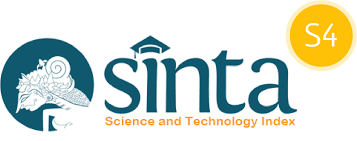Pengembangan Model AI Menggunakan Algoritma Intensity Of Character (IoC) dan Reduced Support Vector Machine (RSVM) untuk Transliterasi Citra Aksara Sasak
DOI:
https://doi.org/10.29408/jit.v8i2.31124Keywords:
Sasak script, Classification, support vector machine, transliterationAbstract
The limited human resources who are able to read Sasak script palm leaves are the main motivation for developing a transliteration tool for Sasak script images on palm leaves. By using the Reduced Support Vector Machine or RSVM algorithm as one of the classification methods, transliteration efforts can be facilitated with maximum results. The principle of the RSVM method in classifying objects by separating two different classes using a hyperplane has been proven to be able to produce maximum accuracy performance in this study. The research data in the form of Sasak script images resulting from the palm leaf image segmentation process that has been divided into 18 classes. The feature extraction algorithm used is Intensity of Character (IoC) with window sizes of 3x3, 4x4, and 5x5 and 3-Fold, 5-Fold, 7-Fold data Imbalance. The test results at the RSVM classification stage using the Linear Kernel, Polynomial Kernel, Radial Basic Function (RBF) and One against One modeling on the 18 classes tested, where each class contains 20 handwritten Jejawen Sasak script image data on palm leaves, were recorded to produce the highest accuracy, which was 93.6%.
References
[1] R. Yulianti, G. Pasek, S. Wijaya, and D. F. Bimantoro, “Pengenalan Pola Tulisan Tangan Suku Kata Aksara Sasak Menggunakan Metode Moment Invariant dan Support Vector Machine (Handwritten Sasak Ancient Script Recognition using Moment Invariant and Support Vector Machine),” 2019. [Online]. Available: http://jcosine.if.unram.ac.id/
[2] F. B. A.A.Sg.Mas Karunia Maharani, “Pengenalan Pola Tulisan Tangan Aksara Sasak Menggunakan Metode Linear Discriminant Analysis Dan Jaringan Syaraf Tiruan Jenis Backpropagation (Handwritten Sasak Script Recognition Using Linear Discriminant Analysis And Backpropagation Artificial Neural Network ),” 2020. [Online]. Available: http://jtika.if.unram.ac.id/index.php/JTIKA
[3] A. M. Andar et al., “JEPIN (Jurnal Edukasi dan Penelitian Informatika) Pengenalan Tulisan Tangan Karakter Aksara Batak Toba dengan Metode Convolutional Neural Network (CNN),” 2023.
[4] A. Jawi dalam Naskah Sarana Walio Inayatusshalihah, “Aksara Jawi dalam Naskah Sarana Walio,” 2020.
[5] H. Kartika Sari, M. Audina, S. Maulida Sunarso, and H. Faizah, “Analisis Penulisan Arab Melayu Pada Tugu Nama Balai Bahasa Provinsi Riau,” 2023.
[6] E. Hernando and A. R. Widiarti, “Transliterasi Citra Aksara Bali Daun Lontar Dengan Algoritma Intensity Of Character Dan Support Vector Machine,” 2021.
[7] L. M. Samsu and A. E. Sutriandi, “Algoritma Denoising & Binarization untuk Perbaikan Kualitas Keterbacaan Citra Takepan Sasak,” Infotek: Jurnal Informatika dan Teknologi, vol. 1, no. 2, pp. 88–95, Jul. 2018, doi: 10.29408/jit.v1i2.902.
[8] L. M. Samsu and I. Fathurrahman, “Adaptive Thresholding Algorithms and Morphological to Improve the Quality of Takepan Sasak Image Readability,” in Journal of Physics: Conference Series, Institute of Physics Publishing, Jul. 2020. doi: 10.1088/1742-6596/1539/1/012031.
[9] M. Saiful, L. M. Samsu, and I. Fathurrahman, “Perancangan Kerangka Crowdsourcing Berbasis Wisdom Of Crowds Untuk Kamus Naskah Lontar (Takepan) Sasak Online,” Jurnal Informatika dan Teknologi, vol. 3, no. 2, pp. 165–173, 2020.
[10] L. M. Samsu, M. Saiful, I. Fathurrahman, and H. Bahtiar, “Digitization of Takepan Sasak manuscipt based on the OPF flipbook,” in Journal of Physics: Conference Series, IOP Publishing Ltd, Apr. 2021. doi: 10.1088/1742-6596/1869/1/012073.
[11] A. R. Widiarti, “K-nearest neighbor performance for Nusantara scripts image transliteration,” Jurnal Teknologi dan Sistem Komputer, vol. 8, no. 2, pp. 150–156, Apr. 2020, doi: 10.14710/jtsiskom.8.2.2020.150-156.
[12] R. Novaliandy, A. R. Widiarti, S. Universitas, and Y. Dharma, Klasifikasi Aksara Jawa Cetak Menggunakan Jaringan Syaraf Tiruan Backpropagation.
[13] I. And and D. Expert, “Prediksi Penyakit Diabetes Menggunakan Algoritma Support Vector Machine (SVM) Informasi,” 2022. [Online]. Available: https://e-journal.unper.ac.id/index.php/informatics
[14] E. Hernando and A. R. Widiarti, “Transliterasi Citra Aksara Bali Daun Lontar Dengan Algoritma Intensity Of Character Dan Support Vector Machine,” 2021.
[15] B. H. Amri Muliawan Nur, “Komparasi Algoritma SVM Dan SVM Berbasis PSO Dalam Menganalisa Kinerja Guru SMAN 3 Selong,” Jurnal Informatika dan Teknologi, 2019.
[16] M. S. H. B. LM Samsu, “Komparasi Algoritma Denoising Dan Binarization Dengan Adaptive Thresholding Dan Morfologi Untuk Menigkatkan Kualitas Keterbacaan Citra Naskah Lontar (Takepan) Sasak,” Jurnal Informatika dan Teknologi, 2020.
[17] R. Yulianti, G. Pasek, S. Wijaya, and D. F. Bimantoro, “Pengenalan Pola Tulisan Tangan Suku Kata Aksara Sasak Menggunakan Metode Moment Invariant dan Support Vector Machine (Handwritten Sasak Ancient Script Recognition using Moment Invariant and Support Vector Machine),” 2019. [Online]. Available: http://jcosine.if.unram.ac.id/
Downloads
Published
How to Cite
Issue
Section
License
Copyright (c) 2025 Infotek: Jurnal Informatika dan Teknologi

This work is licensed under a Creative Commons Attribution 4.0 International License.
Semua tulisan pada jurnal ini menjadi tanggung jawab penuh penulis. Jurnal Infotek memberikan akses terbuka terhadap siapapun agar informasi dan temuan pada artikel tersebut bermanfaat bagi semua orang. Jurnal Infotek ini dapat diakses dan diunduh secara gratis, tanpa dipungut biaya sesuai dengan lisense creative commons yang digunakan.
Jurnal Infotek is licensed under a Creative Commons Attribution 4.0 International License.
Statistik Pengunjung




